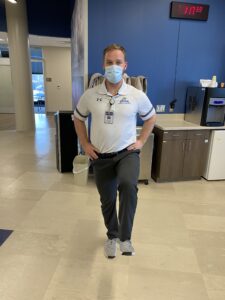“Lumbopelvic Control and the Development of Upper Extremity Injury in Professional Baseball Pitchers” Laudner et.al. 2021
https://journals.sagepub.com/doi/full/10.1177/0363546520988122
How do we as pitchers gather the most energy from the ground as possible? Is it rhythm? Is it leg left? Is it hip hinge? The most correct answer is all of them, but if the body is not able to complete the basic movements with stability first, then we lose potential kinetic energy. The link above is to an article from Kevin Laudner, and in it is the description of some basic tests that I also use to evaluate my pitchers from both a medical standpoint, but also a performance standpoint when I’m coaching. When looking at the article, the big take away is professional pitchers with decreased lumbopelvic control tend to get hurt more than pitchers with increased/better pelvic control.
The two basic evaluation tools are the single leg bridge and a static single leg balance with leg lift (see below). These simple tests can give us good insight into if a younger or older pitcher has control of their pelvis during the windup/leg lift portion of the delivery. Many of my younger pitchers I work with demonstrate poor leg lift (under 90 degrees) and is usually linked to decreased pelvic control.


Both the single leg bridge test and the single leg stance test require you to hold the above positions for a minimum of 30 seconds up to 60 seconds to see if your hip level drops or stays stable through the whole test. If the hips drop, with either test, then some of your workout should include some balance/control work (more on that below).
There is a simple drill progression to help increase control and by association, performance for pitchers of all ages. And I want to be clear, I’m not suggesting there is no place for a slide step or motion disturbances like Johnny Cueto or Nestor Cortes, but when looking at efficiency, these are the basics. Below are 3 exercises to help with pelvic control and 1 transition drill into the pitching motion. Keep in mind the top of our leg lift is not a “balance point” as in we stop our motion, we want to get and keep our motion moving forward once we lift the foot from the ground.
Kettle bell single leg “around the world” – Great starting drill to lean static balance on drive leg. Try to keep your weight even through the foot (not feeling majority of pressure in the ball of the foot). Shoot for 1-2 sets for 15 seconds each (waist and knee) 3 times a week.
Lateral step down – Great for foot connection to rubber and feeling some “hinge” in the drive leg. Can use a step in your house to start if you are younger then 14, and work up to 12 inch step if you are 14+ y/o. Shoot for 1-2 sets for 15 reps 3 times a week.
Single leg stance with knee driver – Great for learning to move dynamically, and can work the knee getting above 90 degrees. Shoot for 1-2 sets of 15 seconds 3 times a week.
Tap/Knock and Go – I’m not really running this drill the greatest, but you can’t hold that against a 33 y/o non-pitcher haha. Get a bucket with a water bottle or something to kick off the top then go. Helps with balance and control. Treat it like innings so 2-3 sets of 15 reps 2 – 3 times a week (not a 100% speed throws).
Dr. David Klaus, DPT, ATC/L
The Pitching Mechanic